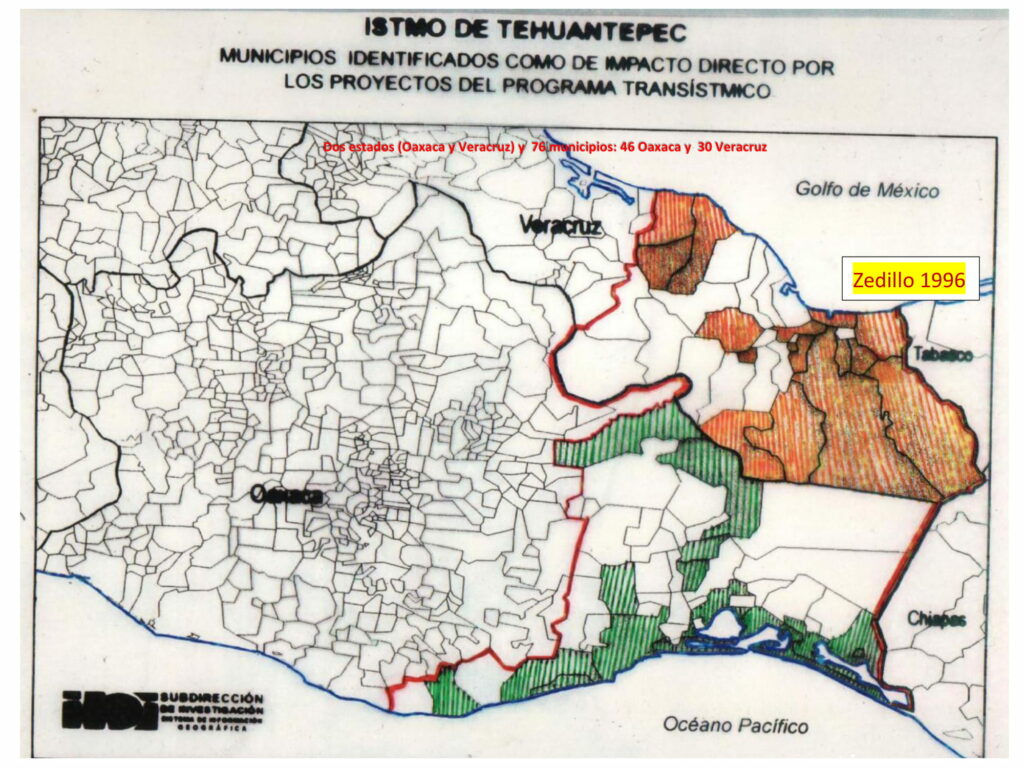by Gilberto López y Rivas
The recycled mega-project of the Tehuantepec inter-oceanic corridor –whose origins lie in the regional development program of Ernesto Zedillo’s government, and whose distant origins lie in the damaging McLane-Ocampo Treaty (1859)– continues its slow but relentless advance, despite the opposition and resistance of multiple local, regional, national and international organizations and collectives that have exposed the serious damage that this monstrous project will cause to the environment, to the peoples who inhabit the disputed territories, and to the whole socio-political-cultural fabric of the 33 municipalities of Veracruz, 46 of Oaxaca, 14 of Chiapas and five of Tabasco.
Let us remember that this is an comprehensive project and, consequently, it is not simply the passage of goods from one ocean to another through a multimodal railroad, but also includes the modernization of the ports of Coatzacoalcos and Salina Cruz, a parallel network of highways, 10 agro-industrial and industrial parks or corridors for the chemical, petrochemical, oil and gas industries, petrochemicals, petroleum, refineries, wind farms, hydroelectric dams, automotive and machinery assembly plants, manufacturing of other products, gas and oil pipelines, timber plantations, and high voltage power lines, as well as hotel infrastructure, services and communications for luxury tourism. All this with tax subsidies and the guarantee of basic services to investors.
From a geopolitical perspective, the Isthmus of Tehuantepec megaproject is strategic for the interests of the United States in the economic and military control of Mexico, in its hegemonic implications of dominance over the rest of Latin America and the Caribbean, and in its repositioning vis-à-vis other emerging or competing powers such as China, Europe and Japan. According to the Latin American Observatory of Geopolitics: One of the challenges of this moment concerns the hegemonic dispute between the United States and China, in which powers of nearby heights such as Russia are also participating. In this context, the control of space, seas, territories, routes and the elements defining positions of advantage or vulnerability, the conditions for establishing alliances, coalitions or alliances are of vital importance. Those strategic transit territories such as Suez, Panama and the Isthmus of Tehuantepec are crucial to consolidate the balances or asymmetries of world power and become rigorously guarded territories, even militarily.
It is no coincidence that, as we anticipated more than a year ago (https://www.jornada.com.mx/2021/08/20/opinion/015a2pol), militarization was imposed, in this case, through the handover of the administration of the Isthmus megaproject to the Mexican Secretary of the Armed Marine Corps, the military structure organically closest to the United States, and which, by the way, last September met with the Marine Corps of the United States to sign other collaboration agreements without passing through the scrutiny of the Senate. They agreed to strengthen ties and strengthen the sharing of personnel, training and logistics and troop transport operations by means of an agreement signed by the commanders of both naval forces (www.defensa.com/mexico/acuerdos-colaboracion-entre-armada-mexico-cuerpo-marines-estados).

Miguel Ángel García Aguirre, founder and general coordinator of Maderas del Pueblo del Sureste, A. C., and other organizational efforts in defense of Los Chimalapas, as well as the main promoter of the National and International Campaign #ElIstmoEsNuestro, has insisted on the special significance of the Isthmus for the country, since “it possesses ten different natural ecosystems, which to date are home to more than 10 percent of the biodiversity of the entire planet, It also possesses the most important compact forest massifs -climate regulators and oxygen producers- that still persist in our national territory, the most outstanding massif being the bioregion of Los Chimalapas, and naturally producing 40 percent of all surface water runoff (rivers and streams) in Mexico.”
Resistance against this project began in 1997 and was reactivated in 2019 with the campaign El Istmo es Nuestro (The Isthmus is Ours), whose main purpose is to prevent this triple and severe attack: against nature, indigenous and black peoples, and national sovereignty. More than a hundred organizations and social movements, NGOs and academic collectives, artists and personalities joined this campaign expressing their total rejection of the Comprehensive Development Program.
This article was published in La Jornada on December 4th, 2022. https://www.jornada.com.mx/2022/12/04/opinion/011a2pol
English translation by Schools for Chiapas.
